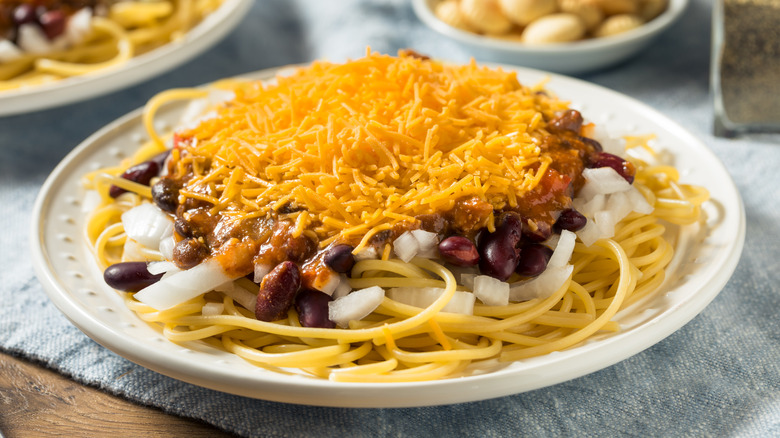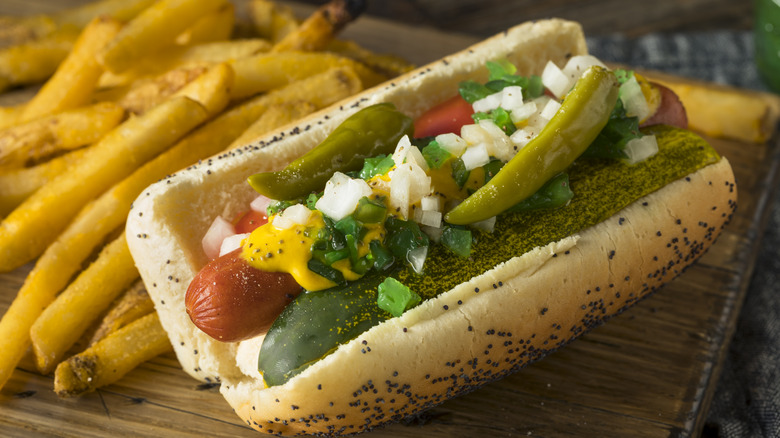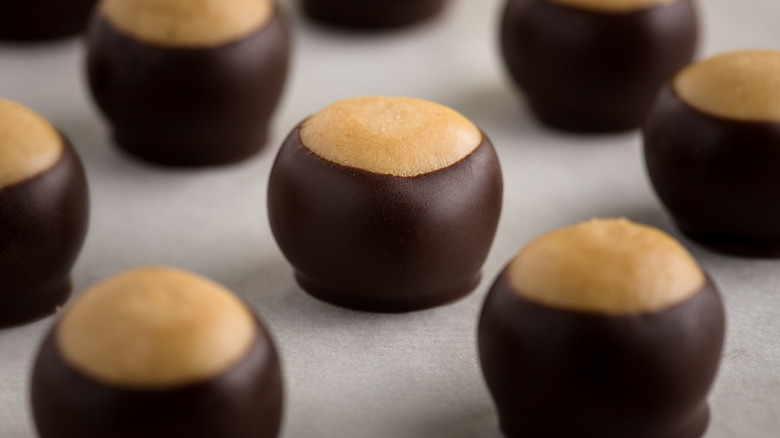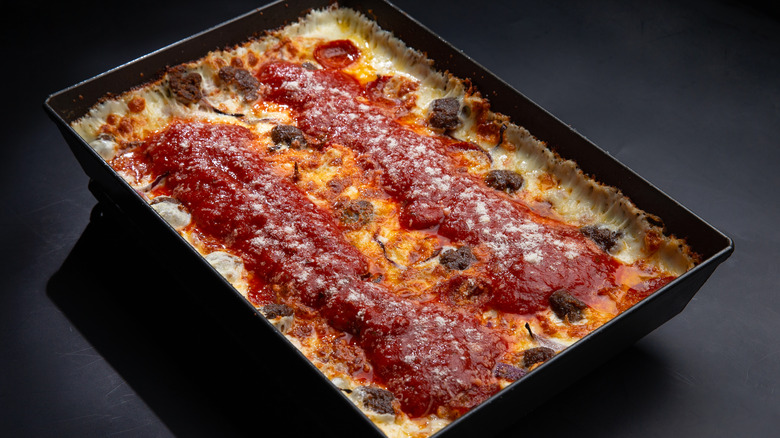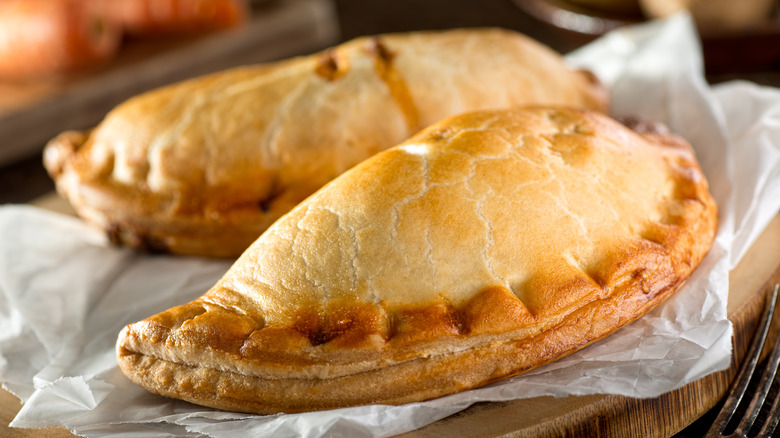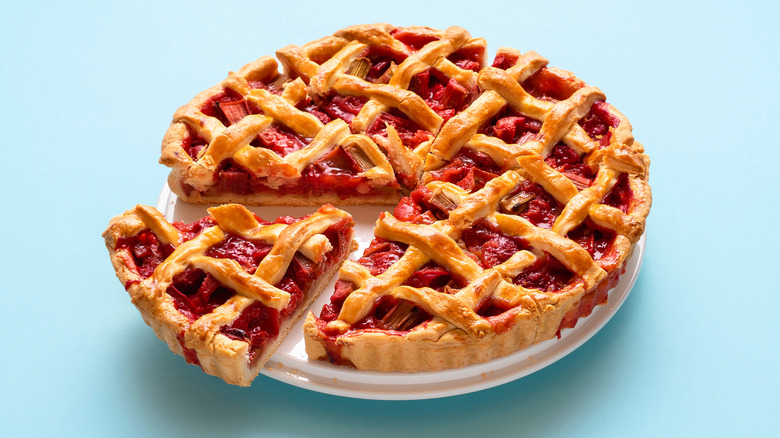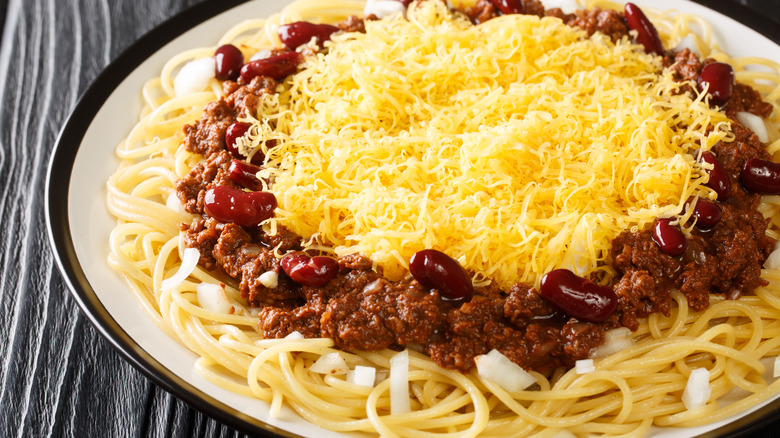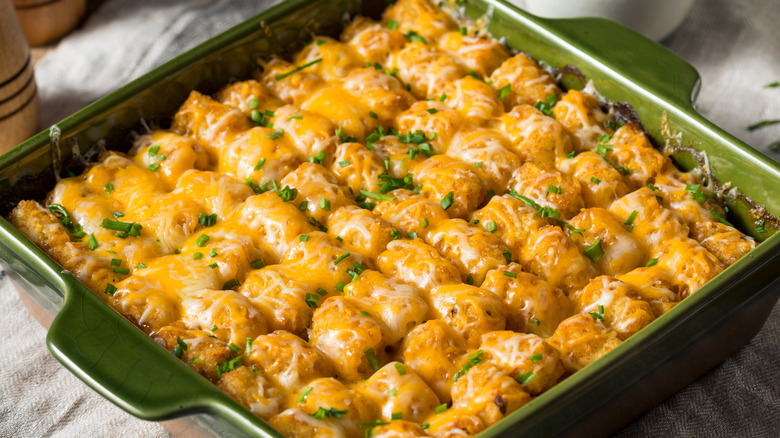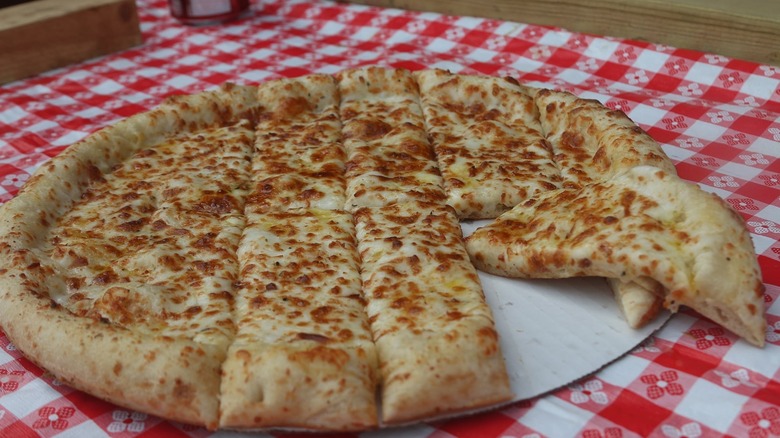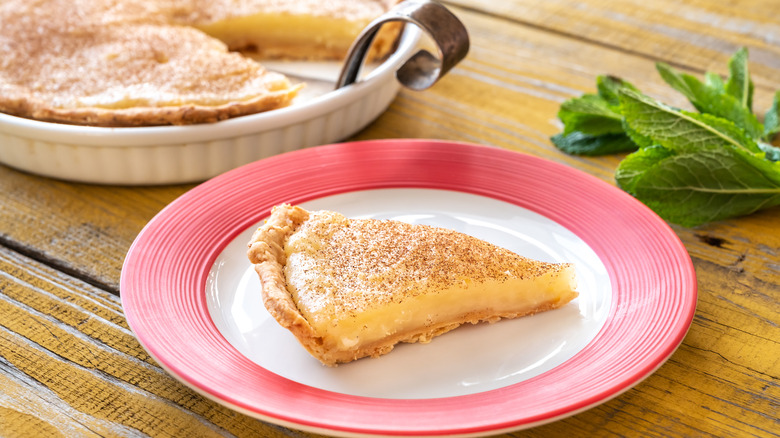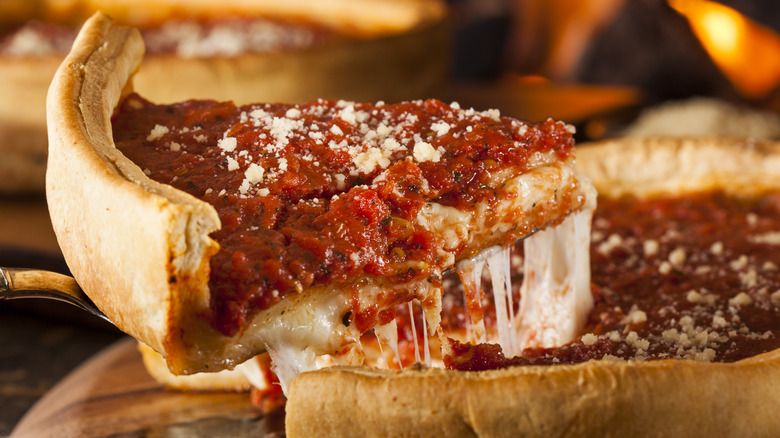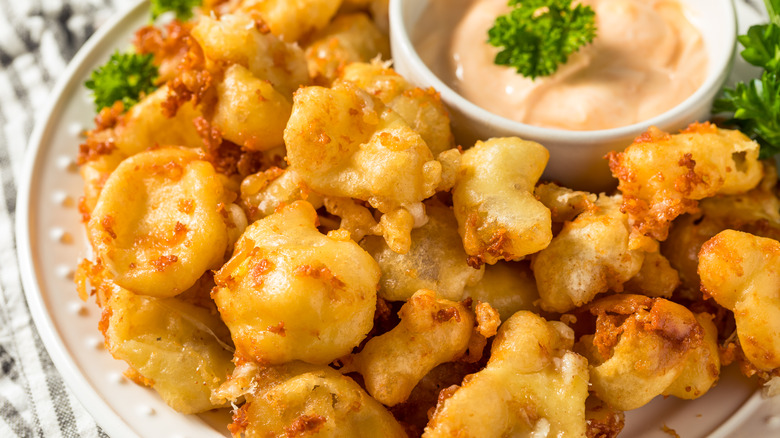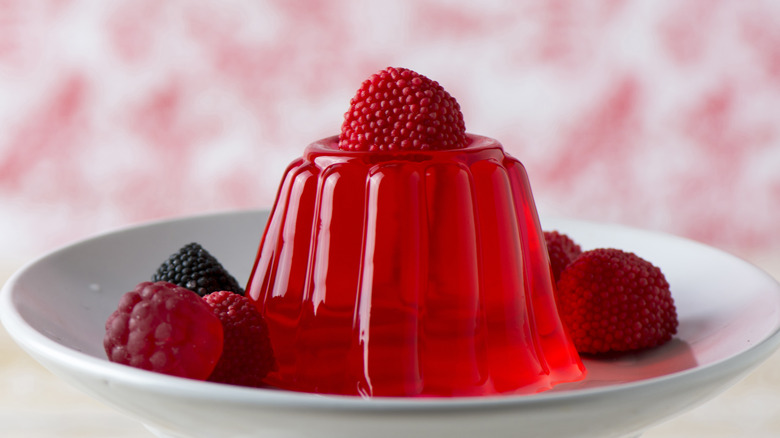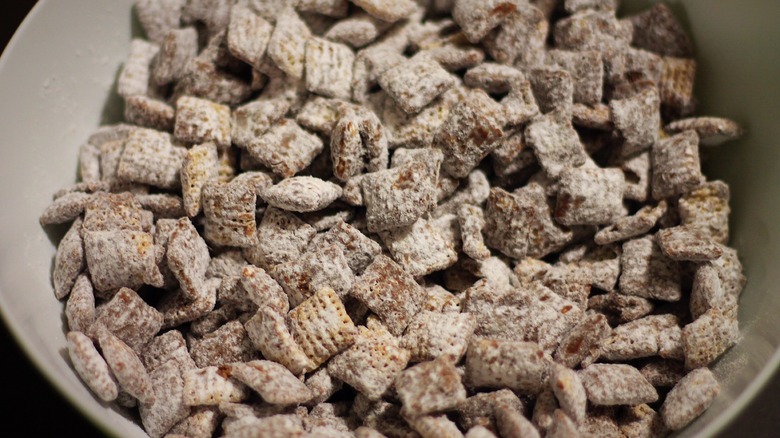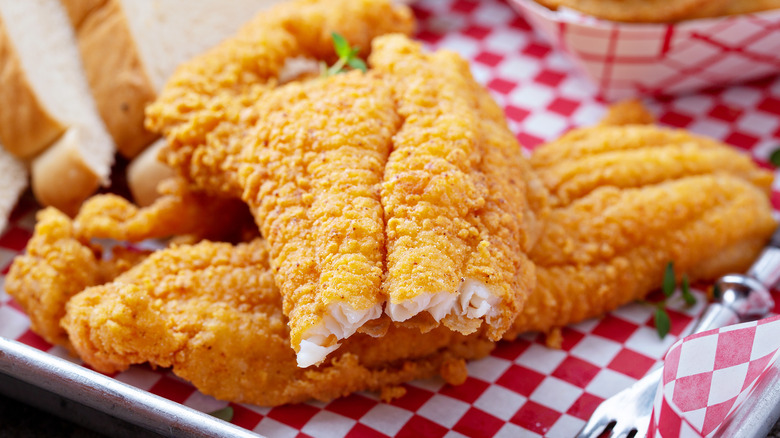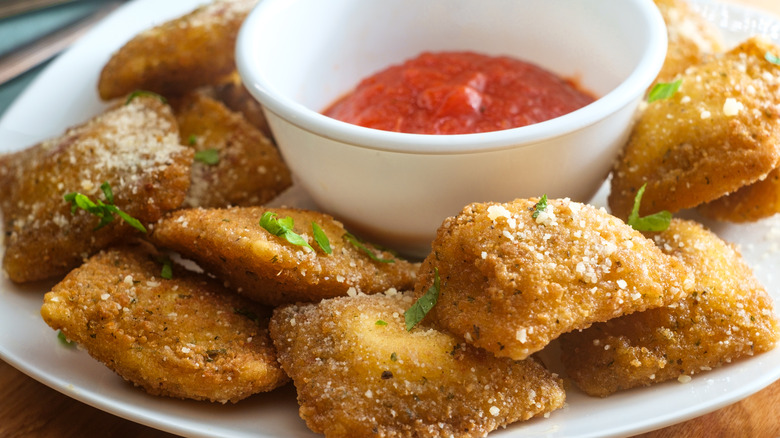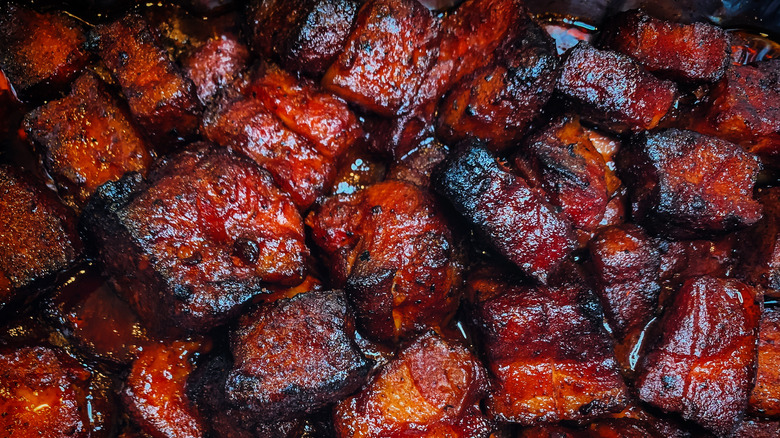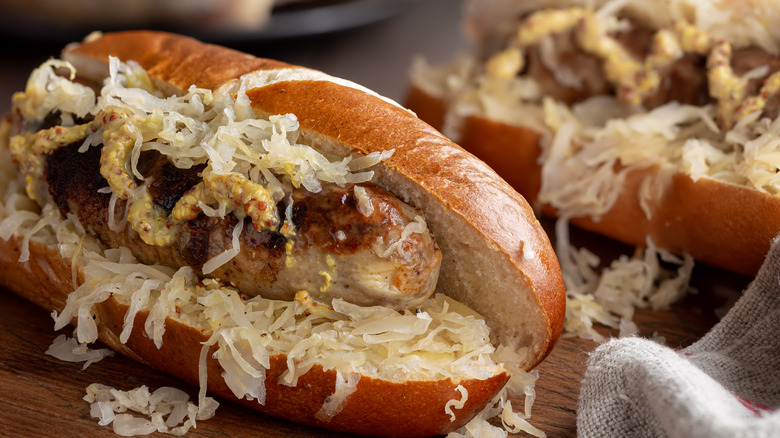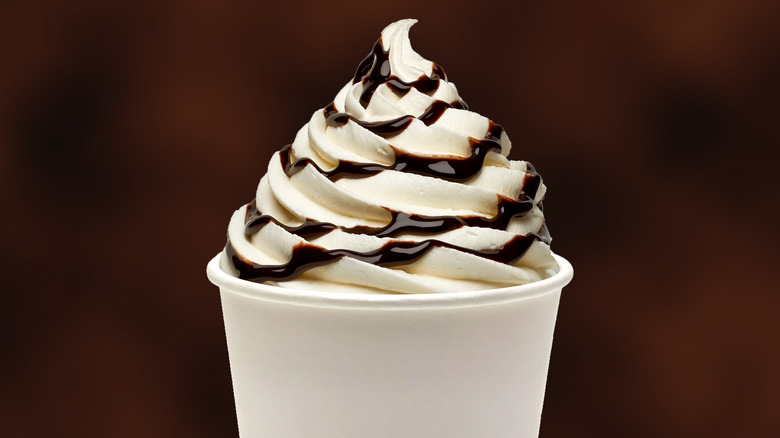18 Iconic Midwestern Foods You Need To Try
The Midwestern United States packs a mighty punch when it comes to regional food. Sure, most attention drifts to New York, Miami, or New Orleans with regard to widely known cuisine. But the Midwest has played an important role in the culinary evolution within the United States, thanks in part to the large number of Irish, Polish, German, and other European immigrants that called the region home during the 18th and 19th centuries. Many of those European dishes came to the United States and took on lives of their own. From Chicago to Detroit, Cincinnati to St. Louis, this large section of the United States has some truly unique menu items, many of which you're only going to find in this pocket of the nation (or, at the very least, you'll be forced to assemble the food on your own if you're outside of it).
So, whether you're from the Midwest and want to see if your hometown favorites are mentioned or you're curious as to what some Midwestern staples are, here's a list of some of the very best meals to come out of the Midwest.
1. Chicago hot dog
This Windy City classic needs to be made very specifically. Any misstep and a Chicago resident will call you out on the spot. It's made with a beef frankfurter, nestled comfortably into a poppy seed bun. It then receives a hit of mustard, onions, relish (the more neon-looking the relish, the better), sliced tomatoes, a pickle slice, and sports peppers.
Known as being "dragged through the garden," the Chicago dog didn't have a set creation date. The pork-free, kosher beef frank first popped up in Chicago right around the Great Depression. Chances are, the Great Depression had something to do with the hot dog's formation, as individuals would put whatever they could on the meal. In fact, some restaurants referred to the hot dog as a Depression Dog. So while the time period wasn't great for the United States, it did leave us with this classic Midwestern food.
2. Buckeyes
Almost every Ohio grandmother has two things in common: They love Ohio State, and they make buckeye candies. This ball of peanut butter fudge dipped in chocolate is about as Ohio as scarlet and gray.
There are a few variations of the buckeye, and it really depends on who is making it. Some use peanut butter fudge, while others use more traditional peanut butter. And still, there are those who prefer to ball up rice crispy treats as the center and then cover them with peanut butter and dip it in chocolate.
This is one of the "newer" additions to the Midwestern array of foods. Truth be told, nobody really knows who originated these desserts. Chances are, someone just wanted to make a snack that looked like the buckeye nut. There is no record of the dessert, which tastes like a very rich, dense Reese's Peanut Butter Cup, before the 1960s.
3. Detroit pizza
This made-in-Michigan pizza has seen an incredible amount of attention paid to it in recent years. Calling this a "square deep dish" couldn't be farther from the truth. Toppings are applied all the way to the edge, the sauce is placed over the top of the cheese (so the cheese oil can soak into the bread), and it even uses a special, angular baking pan to allow for an optimally crunchy crust.
The pizza was first made at Buddy's Rendezvous back in 1946 in Detroit. Beyond using Wisconsin Brick cheese, as well as topping the pizza all the way to the edge with ingredients, it is the shape of the pizza that is truly unique. It isn't just a rectangle. The base of the pizza is narrower than the top, as the pan slopes in from all sides (if someone brings you out a pizza with 90-degree sides, they are not serving you authentic Detroit-style pizza).
The shape of the pizza comes from the shape of the pan used to bake it. Back in the 1940s, the restaurant couldn't find baking pans large enough that could handle the heat of a pizza oven. So, Buddy's instead used automotive pans used for oil drip trays. The angled traps are why the grease from the cheese runs along the sides of the pizza crust, giving it an extra crispy finish.
4. Pasties
Think of this as the English cousin of the empanada if they were made in Michigan. These are very popular northern Michigan hearty dinners, as the pasties are jam-packed with meat and baked to perfection.
The pasty itself has a rather long history. Something similar to the pasty dates back to the 1300s. Because refrigerating meat was impossible, individuals would cook the meat and then add it to baked goods to help extend its shelf life. Most European cultures have some variation of the pasty. The French had their own, as did the British, and as mentioned above, the Spanish had the empanada, which they later brought to South and Central America (which is why basically every Latin American country has some variation of their own).
In Michigan, pasties were important for workers in the Northern Michigan copper mines. There are a number of these pasties, or "meat pies," available in this part of the state. It even eventually spread to neighboring Wisconsin and Minnesota (mostly by copper workers migrating to work in other mines).
5. Strawberry rhubarb pie
Rhubarb used in pies is nothing new. While classified as a vegetable, the tart taste of rhubarb found its way into pies and other baked goods dating back to the 1600s in the United Kingdom. Of course, the UK isn't exactly crawling with sweet fruits, so sometimes you just had to use what you had access to.
This is also another reason why rhubarb found its way into baked goods in the United States as well. While coastal regions and states with warmer year-round weather have fast access to more fruits, the Great Plains region and much of the Midwest had less direct access to fresh fruits.
However, in terms of vegetation production, Michigan has long been one of the most prominent agricultural destinations, thanks to its close proximity to the Great Lakes. Fruits such as cherries, blueberries, and strawberries grow during the summer to autumn months. Eventually, rhubarb found its way into pies with strawberries.
6. Cincinnati chili
When it comes to the culinary offerings of Southwestern Ohio, nothing compares with Cincinnati chili. The chili is consumed not only on its own but slathered over hot dogs, as well as spaghetti (in other areas of Ohio, this is referred to as chili-mac).
During the late 1800s and early 1900s, Eastern European immigrants began making their way to the United States, bypassing New York City for other opportunities in the Midwest. This portion of the United States had a great number of manufacturing jobs (the Rust Belt makes up a great deal of the Midwest). This often resulted in different ethnic groups settling close to one another, especially following the Balkan Wars, as many residents of Serbia, Montenegro, Bulgaria, and Greece ended up in Cincinnati (there are also large pockets around Detroit). The influx led to the creation of a stewed and spiced meat topping that was poured over hot dogs. Eventually, Empress Chili was founded in the early 1920s, where they started to serve the chili over the top of other dishes, like spaghetti. A former Empress Chili worker went to start his own restaurant in 1949 and called it Skyline Chili.
7. Hotdish
Hotdish is more an idea of a food than a specific, cut-and-dry menu item. It is a more specified casserole that hails from Minnesota, but there are some requirements for a casserole to be considered a hotdish. It must include a starch, a meat, and a vegetable (usually canned or frozen), served mixed with a can of soup. Two of the most common ingredients are tater tots as well as cream of mushroom soup.
The menu item very much came from budget-minded individuals who were looking to feed a larger group of people without spending a ton of money. According to the book How to Talk Minnesotan by author Howard Mohr, the dish came about with farmwives needing efficient ways to feed their families. The first credited recipe for a hotdish dates back to 1930, although chances are hotdishes were made long before this.
8. Portesi cheese fries
While called cheese fries, the name can be a bit misleading. They aren't the basket of french fries loaded up with nacho cheese you might assume them to be. Instead, it is more closely related to a cheese pizza minus the tomato sauce than anything else.
Most areas around the Midwest have some variation of the Portesi cheese fries, although most of these variations can draw some kind of connection to the original Portesi Cheese Fries.
George Portesi was born and raised in a small town outside of Pisa, Italy, before moving to the United States by himself at the age of 17. He settled in metro Chicago and eventually opened his own pizza restaurant in the 1950s. Later moving to Wisconsin, he created the Portesi Cheese Fries, which is actually rolled out pizza dough, covered in a garlic spread, and then covered in a heap of mozzarella and spices. It is the unique spices and garlic spread that sets the Portesi Cheese Fries apart from others served elsewhere.
9. Sugar cream pie
It's about time we turned to the Hoosier state of Indiana, and what better way to include one of their entries into the culinary world than a kind of pie also referred to as a Hoosier Pie?
Quakers settling in the state of Indiana created the sugar cream pie as a way of creating pies without the use of eggs. Of course, this is fantastic for anyone with a chicken or egg allergy (yes, you absolutely can eat pies!).
Sugar cream pie has a filling that isn't all that different in terms of consistency from a cheese pie (which is basically the Southern version of a sugar cream pie). The pie also took off in popularity during the Great Depression, as it was still possible to produce a pie with limited ingredients. Eggs, and other proteins, were often limited, so they needed to be used elsewhere.
10. Chicago deep dish
When it comes to Midwestern food, the Chicago deep dish is probably the most known. When you hear "deep dish," you already know what it is because chances are, you've had something somewhat similar.
Of course, true Chicago deep dish is on an entirely different level. It is stacked a mile high and is the kind of pizza that fills you up after a single piece. It's also one of the few kinds of pizza that you simply can't eat without the aid of a knife and fork.
Much like Detroit-style pizza, Chicago deep dish is traditionally served with sauce on top of the cheese and toppings. As for the origin of this pizza, varying individuals claim they made it first, as with any good classic food. The most widely accepted origin of the deep dish is that Pizzeria Uno first served it up in 1943. However, Rosati's Authentic Chicago Pizza began serving a "deep dish" pizza on its menu all the way back in 1926.
Whatever the origin of the Chicago deep dish, there's no denying its place on the Mount Rushmore of Midwestern culinary food.
11. Cheese curds
Fried cheese is nothing new. It dates back to the Middle Ages as, much like many other food origins, individuals looked for ways to extend the shelf life of cheese, and frying the cheese made that possible. Different countries around the world have various versions of fried cheese, but Wisconsin cheese curds are, in many ways, its own entity.
The cheese curd is formed when milk is coagulated during a curdling process. This is done by adding some kind of substance to the milk, such as lemon juice or vinegar. The result of adding this acidity forms small nuggets of cheese. To make Wisconsin cheese curds, the curds are then gathered and deep fried. Because of how cheese curds are formed, they are far firmer than the cheese used in mozzarella cheese sticks.
12. Jello mold fruit salad
You've probably seen the jiggly dessert in a movie or TV show and wondered to yourself if anyone actually made the fruit dessert. They did, and they still do, in the Midwest.
Jello mold fruit salads have a surprisingly long history in the United States. The very first jello salad dates all the way back to 1904, although at the time, it went by the name "perfection salad." It was a recipe submitted to Better Homes and Gardens by Mrs. John E. Cook.
Jello salads took off in the Midwest thanks to its casserole-level versatility. It's possible to put just about anything into the jello mold. In the Midwest, strawberry is a popular flavor, but you will find anything ranging from marshmallows to pretzels inside the jiggly dish. It's a simple dish to make as well, as it doesn't require all the baking of pies, cakes, or even cookies.
13. Puppy chow
Long before Chex started making their own variation, puppy chow had been a Midwest dessert for ages. And it might be the best thing on this list. Chex cereal, coated in chocolate, powdered sugar, and peanut butter is fantastic.
The history behind puppy chow might be one of the most interesting (at least with regard to its name). Back in 1937, Ralston Purina Company began producing Chex cereal (Ralston Purina was the very same company producing Purina dog food).
When General Mills purchased Ralston back in the 1990s, it began marketing recipes for what it referred to as Muddy Buddies. If you are old enough, you might remember recipes for Muddy Buddies printed on boxes of Chex cereal during the holiday season.
However, while General Mills wanted to use the recipe as a means to push additional cereal purchases (not unlike Rice Crispy Treats), recipes for puppy chow pre-dated it by decades. In the Midwest, it went by the term puppy chow literally because Chex was made by a dog food company.
14. Midwestern fish fry
Serving up fish is a popular addition to restaurant menus during lent. However, the classic Midwestern fish fry is a staple at restaurants throughout the region. Often, these "Friday Fish Fry" are all-you-can-eat, and for those surrounding the Great Lakes, perch is a common fish to use. It's locally available, doesn't require shipments from the coasts, and it helps keep the price down. In fact, perch can be fished from the Great Lakes during the winter months as well. It's also good for local fishermen as it helps employ them during months of the year that are not traditionally fishing months.
A classic fish fry is common around other parts of the country, especially those with regions with access to the coast. Still, in the Midwest (specifically Michigan), perch is a unique year-round affair.
15. Toasted ravioli
Everyone knows frying makes everything better. That includes ravioli. Toasted ravioli isn't so much toasted as it is deep fried, but let's be honest; the name "toasted ravioli" just sounds cooler. Legend has it that a drunk chef accidentally knocked ravioli into a deep fryer back in the 1940s and thus began the St. Louis culinary offering. How much truth there is behind that story, it's hard to say, but having a few too many drinks and craving deep-fried food tend to go hand-in-hand, so we'll go with it. Supposedly the brother of a legendary baseball player was at the bar and ate the food at the time. Is there anything more St. Louis than baseball, beer, and deep-fried food? Probably not (unless a Cubs loss is somehow intertwined with the story as well).
16. Burnt ends
Whether you're a fan of Kansas City BBQ or you prefer the sweeter Carolina BBQ, it's hard to go wrong with either. And one particular Kansas City staple is burnt ends. These are the pointed half of a smoked brisket. The charred tips might be the ultimate in BBQ finger foods. You don't have to deal with bones, you can eat them like nuggets, and they are perfect for dipping.
This Kansas City entry into Midwestern cuisine took off after a 1972 article in Playboy mentioned burnt ends as a must-try offering at Arthur Bryant's in KC. In fact, back then, Arthur Bryant's gave the burnt ends out for free, serving them up much in the same way as bar top pretzels and peanuts.
17. Bratwurst
Okay, so we're pushing it a little bit when considering this a "Midwestern" food. Yes, it absolutely was created in Germany and continues to be a German staple. With that said, when German immigrants moved over to the United States, they brought with them their love of sausages, especially in Wisconsin and Minnesota. The creation of the local brat has given hot dogs a run for their money. The American Midwest has very much adopted the bratwurst as it is now served at picnics and cookouts throughout the region, with most states in the Midwest serving locally produced brats. The Milwaukee Brewers also started selling brats all the way back in the 1950s. Of course, it's now offered at most baseball stadiums around the country.
18. Frozen custard
This is basically the opposite of gelato. The Italian dessert, which is similar to ice cream, uses butterfat, which is lower in fat than traditional ice cream and gives it a lighter, fluffier taste and texture. Frozen custard is made with the addition of eggs and is served at a slightly warmer temperature, and the eggs help give it a richer, denser consistency.
While frozen custard was technically created first in Coney Island, New York, it took off in popularity in the American Midwest, with Milwaukee gobbling it up in droves. A number of Midwestern-centered restaurant chains, such as Culvers, have helped spread the dessert to other corners of the United States. If you haven't sampled frozen custard in the past, it is well worth giving this ice cream substitute a try.
